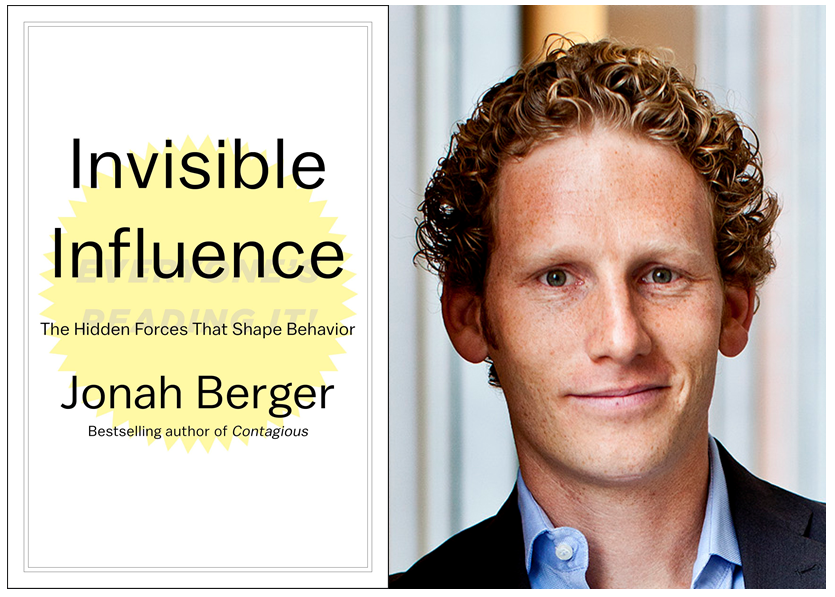Book Review: ‘Invisible Influence: The Hidden Forces That Shape Behavior’ by Jonah Berger
This book review is an article originally published in the Journal of Business and Technology, produced by the School of Business and Technology at Excelsior College.
Following the success of his best-selling book, Contagious: Why Things Catch On (2013), marketing professor Jonah Berger of the Wharton School at the University of Pennsylvania, has published Invisible Influence: The Hidden Forces that Shape Behavior (2016). A work that looks at the social forces that guide our thoughts and actions. Berger is one of those contemporary ‘rock star’ academics, like Dan Ariely, and fellow Wharton faculty Adam Grant, who have moved beyond limiting their ideas to the pages of peer-reviewed journals and succeeded in making them accessible to a wider audience through social media and the TED format. But it should not be forgotten that Berger also has a reasonable corpus of scholarship behind him that upholds his academic credentials and the rigor of his published works.
The author opens by describing one of his earliest forays into studying social influence when he bicycled around a particularly ‘tony’ neighborhood in Silicon Valley to place a survey on the windshield of every BMW that he could find (p2). Berger was trying to unearth the reasons why someone bought a BMW and so, quite logically, he went to where you would expect to find them. Berger concluded that the owners of these status symbol cars did believe that societal influence plays a part in whether someone bought a BMW or not, they just didn’t believe that such forces had any effect upon them. Social influence was, therefore, something that people acknowledged as acting upon others, but were reticent to accept the evidence of any effects upon themselves.
To illustrate this further, Berger’s book challenges the reader to think about a recent choice, whether one as mundane as choosing a place to eat, or as important as selecting the next President of the United States and to question the cognitive, behavioral, and environmental factors that give rise to that choice. In suggesting that we ascribe personal thoughts and opinions as the driving force behind our decision-making, Berger downplays this notion and instead concentrates his focus upon the impact of others as the key influence on what we choose to do and the decisions that we make. And in driving home his point, he provides illustrations of how, for example, the influence of the voting intentions of others encourages us to do the same or how the presence of someone alongside us at the gym, spurs us to run faster on the treadmill.
He groups the societal influences upon behavior into several categories, around which he then provides accessible examples that illustrate them more fully, whether that is differentiation, mimicry, avoidance or imitation. One of the more prominent examples of the latter, which Berger gives in the book is the novel, The Cuckoo’s Calling (2014), written by an unknown debut novelist, Robert Galbraith (p54). While it had initially seen modest sales, after three months had passed it was certainly not a best seller, languished at the bottom of the charts, and facing obscurity. All of that changed, however, when Robert Galbraith was revealed to be none other than J.K. Rowling, the creator of bestselling fictional children’s character, Harry Potter. While the content and the writing remained the same, the perception of the book and the reaction of the buying public changed and created an overnight sensation.
With his captivating style of storytelling, Berger is heir apparent to Malcolm Gladwell, author of The Tipping Point (2002) and Outliers (2008), amongst other works, whose findings the Wharton scholar has previously challenged, while simultaneously acknowledging a debt to both Gladwell’s narrative style and his ability to popularize previously dry topics (Sacks, 2013). But if Berger was a little known scholar before he penned Contagious, he certainly has a higher profile now, even if he is yet to reach the stature and the acclaim afforded to Gladwell. While the book taps into Berger’s extensive research, it does not strive to be a piece of academic writing that explores the data in a scholarly way, rather it self-consciously aims to be a practical manual that helps the individual to make better decisions in the light of its insights.
Ultimately Berger seeks to explain what we do and why we do it, whether that decision happens to be political, emotional, or economic. While he acknowledges our ability to think independently and to act accordingly, his focus is upon societal influence and the way in which our thoughts and deeds are often inextricably linked with our response to others. And in developing the thesis of the book, he dexterously draws upon the eclectic academic output of a range of scholarship, whether that is the social sciences, marketing, psychology, or the field of education, which may suggest that the analysis is spread too thinly in places for specialists within some of those disciplines.
The knowledge and the accessibility of the examples should, nevertheless, appeal to a range of audiences and to readers from different backgrounds. With a focus upon improving decision-making, this book will appeal to the general reader of business non-fiction, but there is also sufficient rigor behind the narrative style to appeal to the scholar. It will resonate with readers seeking to apply its ideas to fields as diverse as management and HR, consumer behavior, marketing, and those who seek to gain a greater understanding of why we make the choices that we do. Ultimately the book doesn’t seem to have the focus and the purpose of Contagious and its breadth could be perceived as giving it less substance than his first title, but it remains a very readable and engaging book for all that.
References:
Berger, J. (2013). Contagious: Why Things Catch On. New York, Simon and Schuster.
Galbraith, R. (2014). The Cuckoo’s Calling. New York, Mulholland Books.
Gladwell, M. (2002). The Tipping Point: How Little Things Can make a Big Difference. New York, Little, Brown and Company.
Gladwell, M. (2008). Outliers: The Story of Success. New York: Little, Brown and Company.
Sacks, D. (2013, 03). Fifty Percent Of ‘The Tipping Point’ Is Wrong.” Jonah Berger Shows You Which Half. Fast Company. Retrieved 10, 2016, from https://www.fastcompany.com/3006693/fifty-percent-of-the-tipping-point-is-wrong-jonah-berger-shows-you-which-half.
Book Title: ‘Invisible Influence: The Hidden Forces That Shape Behavior’
Author: Berger, Jonah
Publisher: Simon and Schuster
Year of Publication: 2016
ISBN: 978-1-4767-5969-2
Price: $26.99



